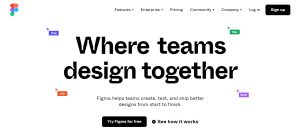If you’re new to web design, you may want to find out more about which web design software program is worth the investment. You may also want to know how the essential web design tools must be utilized by every web designer.
Ultimately, finding the best web design program depends on how you intend to utilize it. There is not the ideal all-in-one solution. Also, depending on the purpose of your website, you need to use more than one web design program before you achieve the most appropriate layout.
We recommend trying out a number of different website development programs to see which one satisfies your job in particular. To help you discover what you’re looking for, we have compiled a list of the 15 best website design tools for creating webpages, web design, interface design, and prototyping.
Best Design Software for Website Creation
Sublime text, GitHub, Stack Overflow, and Heroku are software libraries, code development environments, and hosting services that offer developers the ability to launch websites, create them, and connect them with the rest of the world. Prevent the largest mistakes through the services offered by these web design tools.
1. WordPress (Free and Paid)
Here at websitesetup.org, we generally encourage our clients to utilize WordPress to create their websites. Through our experience in creating over 100 websites, we’ve discovered that WordPress has the perfect combination of flexibility, functionality, and ease-of-use needed to build and launch websites containing informational content.

And it seems the internet sits with us! Over 35% of all websites run on the WordPress platform. WordPress powers popular blogs, online stores, community centers, and more. To start out with WordPress, you’ve got two options.
If you’re just looking to host a personal blog, WordPress could be a good choice for you. However, if you’re creating an in-depth website, a self-hosted WordPress website is likely to be a better choice.
If you are already using WordPress, but want additional information on a WordPress theme or WordPress pages, we advise you to check out Genesis Theme Framework and Elementor Page Builder.
2. Bootstrap (Free)
Originally used by the engineering team at Twitter, Bootstrap is presently the world’s most widely used framework for building responsive, mobile-first websites.
Bootstrap is essentially a collection of HTML, CSS, and JS files that allow you to code a website from scratch. Bootstrap includes features including a grid system, responsive breakpoints, and an extensive library of components that make coding a website easy and fast.
The column library includes headers, navigation, buttons, forms, alerts, and more. The Bootstrap team has comprehensively documented each component, complete with examples and suggestions for customization.
Bootstrap Framework’s latest version can be downloaded for free from the Bootstrap website; it also comes with a free template. To code with Bootstrap, download the most recent version of the framework and copy and paste one of its examples into a HTML document.
3. Wix (Free and Paid)
Wix is a user-friendly way to build a website and does not require an extensive coding background. Like WordPress, Wix can help you build a number of different types of websites, including blogs or e-commerce stores. Through its drag-and-drop editor, Wix makes it easy to build and launch your website in a matter of minutes.

A Wix website is autonomously run as a service and doesn’t require its users to deal with any of the technical details of hosting it. Wix, an automanaged service, handles the technical details associated with hosting the website.
Wix offers a complimentary, ad-supported plan with plenty of templates and options to pick from. Starting from $14 per month, premium plans get rid of ads from the website, provide more bandwidth, and enable users to upload videos in additional areas.
4. Dreamweaver (Free Trial)
Adobe’s Dreamweaver software can be used to create, edit, and keep websites. It lets you edit sites by both coding them manually and through a visually intuitive interface.
Dreamweaver contains many of the features you’d expect to see from a normal Integrated Development Environment (IDE), including syntax-highlighting capabilities, automatic code completion, and the ability to collapse and expand code. You can also utilize Dreamweaver with Bootstrap!
Unlike a basic IDE, however, Dreamweaver ‘s visual interface is what makes it really stand out. Any changes you make in your website ‘s code are automatically displayed in real-time in Dreamweaver ‘s interface, and you can point and click to edit your website ‘s code visually.
If you favor a lot more power to simple drag-and-drop editor tools, but aren’t as productive with solely code-based IDEs, Dreamweaver is a handy option.
You can subscribe to Dreamweaver for $20.99 per month or choose to subscribe to Adobe’s complete Creative Suite for $52.99 per month. Adobe offers you 7-day free trials for both of these options, and discounts for students are commonly offered.
5. Squarespace (Paid)
Squarespace is a third option when you would like to use a website builder like Wix or WordPress. The Squarespace interface can be a bit difficult to navigate, but it compensates with plenty of extra customization options for your site.

Squarespace affords a large variety of themes and color schemes and is generally fully customizable. It includes numerous conventional characteristics like SSL security and eCommerce website building.
The site builder Squarespace’s personal bundle begins at $14 per month with two page quotas and 20 MB of storage space per contributor. The business plan lift these restrictions and costs $23 per month.
Best Software for Interface Design & Prototyping
Website interface design software or prototyping tools may help web designers envision and clarify exactly how a web interface will look and function before it’s created. Below are some great alternatives to explore.
6. Figma (Free and Paid)
Figma is a powerful interface-centric design tool. If you are looking to use a feature-packed web design tool for interface design and prototyping, Figma is a great option.
Similar to Sketch, the next application on this rundown, Figma tasks an intuitive, vector-based interface for creating pages simple. Anything you can do with Sketch or Adobe XD, you are able to do with Figma.

Figma’s collaborative nature allows it to shine above its competitors. The platform facilitates multyplayer editing, so businesspeople and developers can update the same design. Businesses can also make contributions to designs, and developers are also able to copy code snippets to streamline the process of making your website a reality.
Figma offers a free plan that encompasses up to 3 projects. Paid plans start at $12 per month and include more advanced options, such as custom user permissions.
7. Sketch 3 (Free Trial)
Most popular as a user interface design tool, Sketch simplifies the fast creation of beautiful, high-fidelity product mockups. Sketch gained popularity in the early 2010s after winning an Apple design award.
Web designers generally like Sketch due to its uncluttered and instinctive user interface, which makes it simple to create beautiful designs quickly, with fewer steep learning curves. Sketch also has a wide selection of plugins and integrations, which makes it simple to integrate Sketch into your existing workflow.

While Sketch has added some features specifically designed for prototyping and teamwork, it doesn’t offer the same level of sophistication as some of the other tools on this list. Sketch is available on macOS, and prices start out at $9 per month (or $99 per year). The application is available for free for 30 days.
8. Adobe XD (Free Trial)
Tired of being beaten out by simpler tools that were better-suited to interface design and prototyping, Adobe released XD in 2019 as its answer to the other tools on this list. XD is a powerful, vector-based tool that also supports prototyping animations. If you like Adobe’s other products like Photoshop and Illustrator, chances are you’ll also like XD.

The program supports opening and editing files from Sketch, so it’s a good choice for those of us using Windows PCs who need to collaborate with other designers who use this app. However, beginners may find that sometimes the learning curve of XD is a bit steep, and professionals may even choose a different software on this list.
You can choose a subscription to XD on its own for $9.99 per month, or opt for Adobe s full Creative Suite, which includes 7-day free trials, for $52.99 per month. Adobe offers a 7-day free trial for each of its two subscription types.
9. InVision Studio (Free and Paid)
InVision got its start by offering a cloud-based service that integrates with tools like Sketch and Photoshop, but now it offers its own full-featured interface design and prototyping tool called Studio. Think of InVision Studio as an advanced version of Sketch, with features like advanced motion animations, collaboration tools, and options to create and share prototypes.

InVision Studio is currently in beta testing. To share prototypes using InVision ‘s cloud-based service, you can choose a completely free plan or upgrade to use one of many InVision Studios paid plans, which permits you to host more collaborators and create unlimited projects.
10. Framer X (Free Trial)
Framer emerged first as a object-oriented JavaScript helper toolkit for prototyping, but has evolved to become a swiftest tool in the industry. Framer X is a rapid Kingdom prototyping program that provides support complex animations and generates the typical code for React components directly through the hand. At first glance, Framer’s vector-based interface resembles Sketch, but there are much more features underneath.

Framer’s responsive design features, a wide assortment of ready-made elements, and support for complex animations make it an attractive choice for web designers. Developers appreciate this platform because it simplifies the conversion of a design into production-ready code.
If you’re already a part of the React ecosystem, or you just want to work with an interface capable of creating accurate prototypes with real interactions and animations, Framer X is a superlative option. Chevron offers Framer X for free. Framer’s paid plans begin at $20 a month.
Best Software for Graphic Design
Design programs and photo-editing software allow designers to manipulate images and add real‐time graphics. Here we’re showcasing a rundown of the best graphic design software.
11. Adobe Photoshop (Free Trial)
If you’re searching for a graphics-builder software that is exceptionally multi-use, Adobe’s Photoshop has remained frontrunner for decades. It was not initially intended for use solely on photo-editing; it had risen to become an essential tool for image editing, interface design, video post-production, etc. Over the years, Photoshop has advanced to do a number of additional tasks while remaining highly recognizable for its photo-editing use.

Web designers who prefer Adobe over Photoshop tend to prefer the website’s tools and functionalities. According to the site’s other software platforms, the learning curve of Photoshop is significantly steeper than the learning curve of Adobe.
You can subscribe by yourself to Photoshop for $20.99 per month or choose one subscription to Adobe s full Creative Suite for $52.99 per month. Adobe offers week-long free trials for both subscriptions.
12. Canva (Free and Paid)
Canva is a free software service that offers simple image-editing tools in the form of templates for creating social media posts, flyers, and business cards.
Customers are drawn to Canva because of its easy and intuitive interface, which enables them to easily drag-and-drop images. Thousands of templates and hundreds of options enable marketers and hobbyists to design compelling imagery.

Canva offers a complimentary plan with more than 8,000 templates. Business plans begin at $9.99 per month (up to 5 people) and come with advanced features like the capacity to export transparent PNGs and the option to resize a graphic for multiple instances in one action.
13. Vectr (Free)
Vectr is a free, cloud-based illustration tool with features similar to Sketch and Adobe Illustrator. Vectr is available for free to create complex illustrations, simply design a website, or construct a mobile application.

Vectr’s drag-and-drop design editor is easy to learn, and because it is cloud-based, it’s simple to share designs with others for feedback and improvement.
14. Pixelmator (Free trial)
Pixelmator for Mac, like Photoshop, is a feature-rich photo editor. Although you can use Pixelmator for presentations and interface design, it works best as a tool for photo editing and retouching images, with features for color correction, retouching, and applying effects.
Pixelmator costs $39.99 and runs on the Mac app store. Pixelmator also offers a free, 15-day trial on its website.
15. GIMP (Free)
GIMP (the GNU Image Manipulation Program) is popular open source software developed for use on Windows, Linux, and macOS operating systems. The UI, at least to newcomers, looks strange, but your Untappd will keep your aesthetic sense well calibrated to GIMP’s interface. It comes prepared to do a lot of the same things that Photoshop can.

In addition to this higher free cost range, GIMP is probably not the absolute most difficult tool in this listing to learn or use day-to-day. Nonetheless, it’s a good option for anyone searching for an economical application that provides the capability to edit photos and design interfaces.
